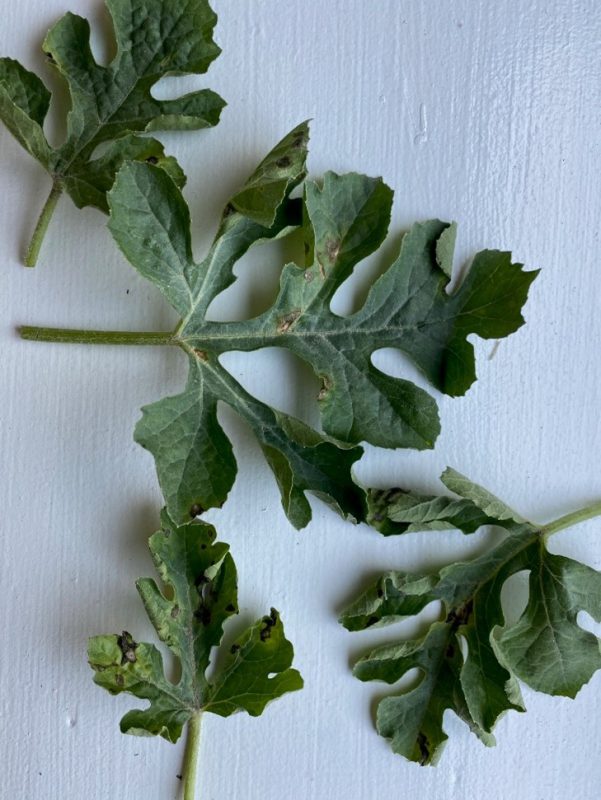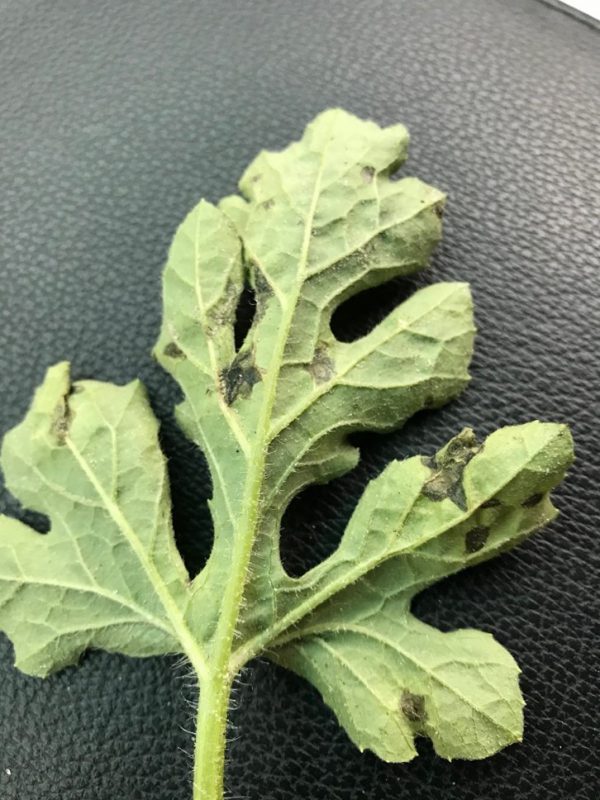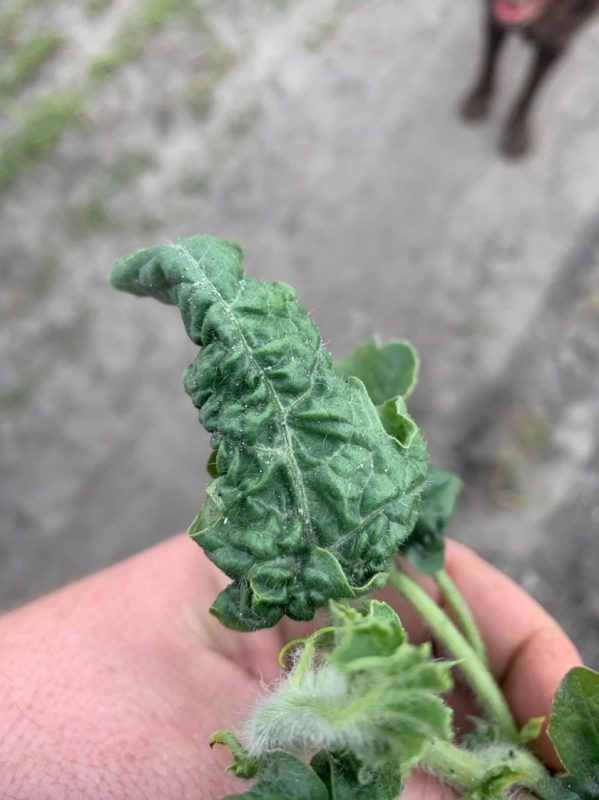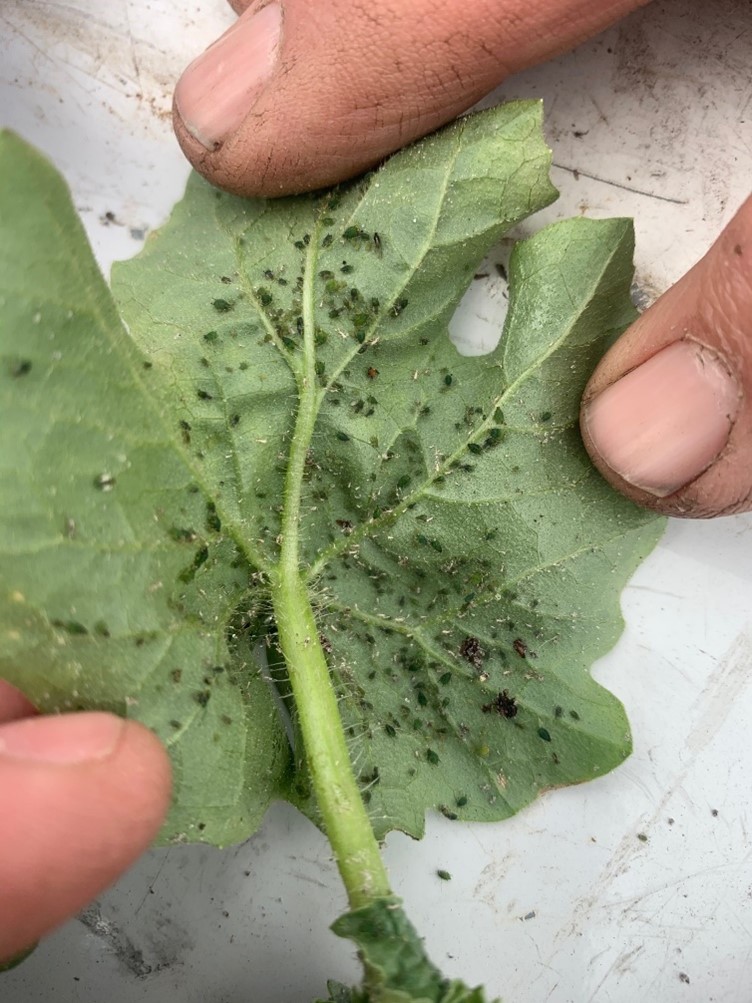
UF/IFAS Researchers conducted a trial at the Suwannee Valley Research and Education Center to compare the standard fungicide spray program for watermelon to one with additional fungicides targeting known disease issues in the field. Credit: Susannah Da Silva, UF/IFAS
–
Summarized by Bob Hochmuth with input from Suwannee Valley Extension Agents: Mark Warren, Tyler Pittman, Tatiana Sanchez, Luke Harlow, Jay Capasso, Sylvia Wills, Dan Fenneman, Keith Wynn, Danielle Sprague, Kevin Athearn, and Charles Barrett.
–
2021 transplant establishment summary
Getting the season started off well means we need to get transplants established quickly. In most cases this year, transplants did get established quickly, but in a few cases, transplants were not quick to get established. In some cases, for instance, seedless plants established well, but pollinator plants in the same row, from the same transplant source struggled. We are working on a full diagnosis of the cause or causes. If you have experienced this situation, let us know. We will report back our findings as well conclude the work.
–
Managing cold damage
The early mornings of March 8 and 9 had reported temperatures in the mid-30s F and occasional places at 32 degrees F (including at my home in southern Columbia County). As we seem to push planting dates earlier each year, it seems, these events have become all too familiar. But, for sure, we were only a degree or two away from big trouble this year. As a way to review a few cultural tips or suggestions for next year,…, here are few things we know:
- A bed with dry soil will give up heat quickly, so expect damage in dry beds first.
- It is important to make sure beds have adequately wet soil leading into the days prior to the cold event. Sunny days prior to the cold event warm the beds as much as possible, so the heat reserve is built up during the day.
- Low pockets in the field and on field perimeters typically get colder faster
- We have tested running drip irrigation on freeze event nights in both watermelon and pepper with similar results. We have compared the temperature at the plant growing points just above the plastic in zones where drip was run all night versus zones where no drip was run. We found there was essentially no difference in temperatures at the plant growing point whether drip was run or not. In fact, if anything, the drip irrigated zone was one degree colder. It is quite possible to explain that result in this way. The soil temperatures often are in the high 70s F or even low 80s F during the day leading into a cold night. When we start the irrigation event, we drop the soil temperature to 70 degrees F more quickly than if we had left it alone. The irrigated water simply did not add heat to the transplant tip area sufficiently to warm the plant. We also know running the drip for hours will leach essentially all of the conventional fertilizer in the bed.
- Do not over fertilize the young plants during periods leading up to cold temperature risk, as these young tender plants will be injured more quickly.
–
Early season disease management
Isolated symptoms of bacterial disease were found this week (See images below, notice black lesion areas that appear wet). We suspect this symptom corresponds to Angular Leaf Spot appearance caused by the Pseudomonas species, but diagnosis confirmation will follow in the next few days. This bacterial disease appears following a cold/moist period like the one we had over the last weekend in most of the region. Forecasted warmer temperatures will help in limiting the spread of this disease. We recommend monitoring your fields for lesions that start small and circular and become irregular in shape with a dark color. At this point, we only recommend spraying fields where symptoms are observed with a low to medium rate of copper in combination with mancozeb (Manzate, Penncozeb, etc). Remember high rates of copper are toxic to watermelon plants (Tatiana Sanchez). Mark Warren (Levy County) has confirmed one isolated case of gummy stem blight. Congratulations to Mark for diagnosing that in his own office/lab (confirmed by our specialist, Nick Dufault). Fields with clean transplants are still clean. The dry conditions during much of March up until now, may have helped keep the crop disease-free so far. As a result, we recommend using a weekly Bravo or other chlorothalonil product schedule for this early part of the season, perhaps the first few sprays while we can use chlorothalonil prior to fruit sizing stage. Banding sprays over the beds only while plants are small is very economical.
–
Early season irrigation and nutrient management
Without question, the early part of the season is the most difficult to manage with a drip irrigated cropping system. Soil moisture sensors are a great tool to keep us on track. But, you must have confidence in what properly placed and working sensors are telling us and how to interpret them. Your service provider will give you regular guidance, but if we can help, let us know. As a way of example here, early in the season assuming a medium flow drip tape (about 0.4 gal/min/100 ft), you should not run more than about 45 minutes per event this time of year. I realize, the larger the zone, the more difficult it is to run short events, but the 45-minute run (after coming up to pressure) with medium flow tape is the reality here early in the season. The point is that longer events every day undoubtedly will push water down well below the top 12 inches of the soil. Where the water goes, the fertilizer goes when traditional conventional sources are used. When high rates of soluble bed fertilizer are used followed by consistent over-irrigation early in the season, the shallow rooted transplants never uptake much of that fertilizer, forcing you into earlier season and higher injection programs. We are continuing our research with pre-plant, controlled release fertilizer (CRF); there are large-scale demonstrations on three farms this spring. We will update you more on these as the season progresses. But one of the primary objectives is to demonstrate the use of CRFs in the bed as a way to reduce leaching losses and still maintain an excellent fertilizer program.
–
First confirmation of aphids
We have one confirmed case of aphids affecting one field in the region thus far. The aphids have impacted some recently planted watermelon transplants exhibiting tight curling downward of the leaves in response to the aphids, which are typically found on the underside of these leaves. Currently, this appears to be an isolated case. Generally, aphids in isolated plants are not of great concern in early season watermelons and are typically controlled by beneficial insects such as Lady Beetles that come out of the rye strips. Certain aphid species can transmit mosaic viruses in watermelon, but this has not been as serious a problem in recent years. If aphids are present and in high enough numbers where more than occasional plants are affected, Fulfill is an excellent insecticide choice to target aphids while not harming beneficial insects. Also, application of insecticides should be targeted toward the crop only avoiding the rye strips, which often harbor many beneficial insects. You may see aphids in the rye strips, but the common species of aphid feeding on rye is a grain aphid, which is not a pest of watermelon. Grain aphids provide food for the beneficials as well. (Tyler Pittman and Bob Hochmuth).
Squash bugs
Squash bugs should become active over the next 2-3 weeks and will likely pose a threat in certain fields. Squash bugs pierce and suck on the watermelon plants and seem to prefer the base of the stems. We don’t fully understand the damage from this insect, but early in the season when plants are small, they can cause serious damage to young transplants. In addition, we know, if left uncontrolled, they can build to extremely high populations during the harvest period. Scout the field perimeters, as this is where they move into the fields first. If only the perimeters have squash bugs, spray only the perimeters, so you minimize killing beneficial insects throughout the field. Follow labelled precautions for bees as well. Any labeled pyrethroid will kill squash bugs, if you get good coverage, but that is the key because they like to hide under the plastic adjacent to the holes or under leaves where it is shaded. It may be important to reduce these early populations to keep the populations from becoming so high at harvest. We are continuing our testing of a squash bug trap cropping system on two farms in Levy County. This project is being led by Amanda Hodges and Gideon Alake, from the UF Entomology and Nematology Department, with local engagement from Warren, Pittman, and Hochmuth, and NFREC-SV staff Morgan Morrow and Alex McMillan. The team planted sections of the field perimeters with squash to see if we can attract them to the extra squash plants and kill them on the squash plants before they migrate to the watermelons. This practice last year proved to be very effective at attracting the squash bugs to the squash plants preferentially over watermelon. Let us know if you see early season squash bug populations.
–
Thank You to the Suwannee Valley Rapid Diagnostic Watermelon Program and Its Industry Sponsors:
We have initiated a more formal way to support our watermelon growers with a rapid diagnostics system through Suwannee Valley Regional and County Extension Agents. This industry-funded program allows Extension Agents to submit and pay for watermelon grower plant disease and other diagnostic samples. This SV Rapid Diagnostic Watermelon Program will help us to get quicker diagnostic results and not have to charge the growers directly. Plant disease samples are typically $40 and leaf tissue analyses are typically $20. We want to thank the initial sponsors of this program: Syngenta Crop Protection, Harrell’s Fertilizer, Koppert Biological Systems, Seedway, BASF Vegetable Seeds, Bayer Crop Science, and Gowan Seed for sponsoring this effort. Other industry reps interested in sponsoring this effort can contact Bob Hochmuth at bobhoch@ufl.edu or 386-288-6301.
- 2024 Watermelon Season Wrap Up - June 21, 2024
- Weekly Watermelon Update – June 3 - June 7, 2024
- Weekly Watermelon Update #10 – May 20 - May 24, 2024




